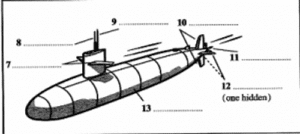The development of travel under the ocean Reading Answers
IELTS Academic Reading Passage
For millennia, humans have been intrigued by what lies beneath the sea and although submarine travel was attempted from time to time, it did not become commonplace until the middle of last century. Several clever and innovative people had experimented with designs for submersible boats before then, but there was much loss of life and little success.
There had long been use of a primitive diving bell for exploratory purposes, but it was as a war machine that the submarine came into its own. The first development in the history of American submarines was a small submersible with a hand-cranked screw-like oar and a crew of one. It was built before the American Revolutionary War (1775—1783) but was adapted for use against the British during this war. Although its pilot twice failed to fasten explosive devices to British ships before losing control of his vessel, he escaped harm.
In 1800, an American inventor, Robert Fulton, designed an underwater machine that he called the Nautilus. This version brought in features that can still be found in some modern submarines, notably adjustable diving planes for better underwater manoeuvring, dual systems of propulsion, and a compressed air system that allowed it to stay down for about four hours without surfacing.
Development of submersible vessels lagged a long way behind the continued progress in the design of surface ships until the American Civil War (1861-1865) when both sides tried out various designs. One of those, called the Hunley — named after its 8nancier rather than its inventor, sank twice during training missions with 11 crew members losing their lives including Hunley himself. Notwithstanding these failures, it was commissioned again in 1864 to attack a ship in Charleston Harbor. A torpedo was used to strike and scuttle the ship – a 8rst in naval history, but the submarine never reappeared, and once again the whole crew perished. Its potential had been recognised, but there still remained the challenge of operating safely under the water.
The US Navy could appreciate the strategic benefits of having submarines in its ;eet and held a competition to encourage design and construction of these underwater craft. The inventor, John Holland, won the competition and it was his sixth prototype, the Holland, that the navy bought and added to its ;eet in 1900. This submarine was quite different from previous designs. It was propelled by a gasoline engine that turned a propeller while the vessel was on the surface. When it submerged, the engine ran a generator to charge batteries to operate an electric motor. The improved propulsion methods were, unfortunately, highly dangerous. Not only is gasoline ;ammable and unstable, using it in the restricted environment of a submarine posed quite a hazard for the crewmen. There was another problem, too: the batteries were not only heavy, cumbersome and inefficient, but they were also extremely volatile.
During the same period as Holland’s efforts were being trialled, a German scientist by the name of Rudolf Diesel created an engine which used a fuel less explosive than gasoline and which would consequently be stored safely. Another advantage was that there was no necessity for an electric spark to ignite the fuel. These safety improvements combined with better fuel economy allowed Diesel engines to power a submarine for longer on the surface; however, batteries were still needed to supply energy for underwater operation.
Although diesel-powered submarines were successful and used by the US Navy for almost 50 years, the search for a single power source carried on. It wasn’t long before the concept of nuclear power was realised in Germany and taken up by an American physicist, Ross Gunn, who could envisage its potential in submersibles. A research team was put together to adapt the concept of nuclear power for use in submarines. In effect, modern nuclear submarines have on board a small nuclear power plant which produces a great amount of energy. This is used to heat water and create steam which drives a huge turbine which turns the propeller.
There have been many adaptations and technological improvements made to submarines over the years, but the shape is basically the same. Obviously, it is a totally enclosed craft, cigar shaped with narrowed ends. The outer hull is the largest part of the boat and forms the body. The inner hull is designed to resist the considerable water pressure and insulates the crew from the cold. This is where the crew works, eats and sleeps. It also contains the engine room and the apparatus that makes clean air and clean water. Between the hulls are the ballast tanks for controlling buoyancy. There is a tall 8n-shaped sail that comes up out of the hull. Inside the sail is the conning tower and extending from this, to the fore, there is a periscope (through which the captain can see the sea and sky when the submarine is near the surface of the water). Sonar is used for navigation deep below the surface. The other projection from the conning tower is the radio antenna.
Underwater, there are two controls for steering the submarine. The rudder (like a tail 8n) controls side-to-side movement, and diving planes influence rise and descent. There are two sets of diving planes: the forward sailplanes and the stem planes, which are located at the back with the rudder and propeller.
Advancing technology will undoubtedly result in different shapes and modes of operation, and it is quite possible that, in the future, submarines will be manned by robots or computer technology that communicates information to land bases via satellite.
Questions 1-6:
Answer the questions below.
Choose NO MORE THAN THREE WORDS from the text for each answer.
Write your answers in boxes 1-6 on your answer sheet.
1) What kind of underwater device was used to investigate the ocean before submersible boats were invented?
2) What was the crewman of the first American-built submarine trying to do before his mission failed?
3) What gave the Nautilus the ability to remain submerged for a long time?
4) When was a submarine first used successfully to sink an enemy boat?
5) What new type of propulsion did the Holland use on top of the water?
6) For what reason was Diesel’s fuel considered safer than Holland’s?
Answers for 7-13:
Label the diagram below.
Choose NO MORE THAN TWO WORDS from the text for each answer.
Write your answers in boxes 7-13 on your answer sheet.

7 _________________
8 _________________
9 _________________
10 _________________
11 _________________
12 _________________
13 _________________

Solution For: The development of travel under the ocean
Reading Answers
| 1 – primitive diving bell | 8 – periscope |
| 2 – fasten explosive devices | 9 – radio antenna |
| 3 – compressed air system | 10 – rudder |
| 4 – 1864 | 11 – propeller |
| 5 – gasoline engine | 12 – stem planes |
| 6 – less explosive/volatile | 13 – outer hull |
| 7 – sailplanes |
Review and Practice
- Regularly practice with IELTS reading samples and time yourself to get used to the pressure of the exam.
- Review your mistakes to understand where you went wrong and how to avoid similar errors in the future.
Our Books
Master IELTS Speaking Part 1
IELTS Writing Task 1 Book
IELTS Writing Task 2 Book
The development of travel under the ocean Reading Answers Explanation
Comin Soon
Practice IELTS Other Modules
IELTS Listening
The IELTS Listening test assesses how well you can understand spoken English in various contexts. It lasts about 30 minutes and is divided into four sections with a total of 40 questions. The listening tasks become increasingly difficult as the test progresses.
IELTS Academic Reading
The IELTS Academic Reading section assesses your ability to understand and interpret a variety of texts in academic settings. It is designed to evaluate a range of reading skills, including skimming for gist, reading for main ideas, reading for detail, understanding inferences, and recognizing a writer's opinions and arguments.
IELTS Speaking
The IELTS Speaking test assesses your ability to communicate in English on everyday topics. It lasts 11-14 minutes and consists of three parts: introduction, cue card, and a discussion based on the cue card topic.
IELTS General Reading
IELTS General Reading tests your ability to understand and interpret various types of texts. Here are some key areas and types of content you can expect to encounter in the reading section, along with tips for effective preparation.
IELTS Academic Writing Task 1
In IELTS Academic Writing Task 1, you are presented with a visual representation of information, such as graphs, charts, tables, or diagrams, and you are required to summarize, compare, or explain the data in your own words.
IELTS General Writing Task 1
In IELTS General Writing Task 1, you are required to write a letter based on a given situation. The letter can be formal, semi-formal, or informal, depending on the prompt. Here’s a breakdown of the key components to include in your letter
IELTS Academic Writing Task 2
In IELTS Academic Writing Task 2, you are required to write an essay in response to a question or topic. Here’s a guide to help you understand the essential elements of this task
IELTS Exam Tips
To succeed in the IELTS exam, practice regularly, familiarize yourself with the test format, improve your vocabulary, develop time management skills, and take mock tests to build confidence.
Grammer for IELTS
Grammar is the foundation of effective communication in English. Understanding tense usage, subject-verb agreement, and sentence structure enhances clarity and coherence in writing and speaking.
Vocabulary for IELTS
Vocabulary plays a crucial role in the IELTS (International English Language Testing System) exam, especially in the Speaking and Writing sections. Here’s an overview of why vocabulary is important and how it impacts your performance
RECENT IELTS SAMPLES QUESTIONS AND ANSWERS
Walking with dinosaurs
Peter L. Falkingham and his colleagues at Manchester University are developing techniques that...
Money as the Unit of Amount Reading Answers
The most difficult aspect of money to understand is its function as a unit of account. In...
WEATHERING IN THE DESERT
In the deserts, as elsewhere, rocks at the earth's surface are changed by weathering, which...
Nature on Display in American Zoos
The first zoo in the United States opened in Philadelphia in 1874, followed by the Cincinnati...
Can We Prevent the Poles From Melting
Such is our dependence on fossil fuels, and such is the volume of carbon dioxide we have...
Air conditioning the earth reading answers
The circulation of air in the atmosphere is activated by convection, the transference of heat...













